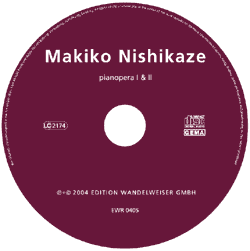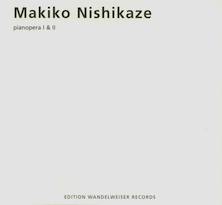EDITION WANDELWEISER RECORDS
> CD catalogue
_____________________________________________________________________
<< >>
Makiko Nishikaze
Pianopera I & II
| order
reference:
medium: composer: performer: |
EWR
0405 CD Makiko Nishikaze John McAlpine, Piano |
 |
 |
> Rezension Stefan Drees (Positionen 63) (german) What struck me most about Makiko Nishikaze’s piano music, when I heard it for the first time, was its waywardness. In a kind of musical stream of consciousness, delicate melodic strands floated quietly and unpredictably over the entire keyboard like the disconnected thoughts of a daydreamer. And yet it sounded perfectly natural and inevitable: some mysterious logic was holding it all together. Immediately I began thinking about how I would interpret this music, and in May, 2002, had the opportunity to do so when she entrusted me with the first performance of her 70-minute long “Piano Islands”. Makiko Nishikaze liked my interpretation, and decided thereupon to compose a further piano piece, the two-part “pianopera”, especially for me. Disliking technical discussions of her music - how it sounds, she says, is more important than how it’s made- all Makiko Nishikaze is prepared to divulge is that she composes system- atically, but with very flexible systems, and that the pitches, intervals and durations she uses are derived from sets of proportions. Before beginning “pianopera I” she carefully measured the lengths of my arms and fingers, the measurements obtained providing the set of proportions for the piece. I was reminded of composers like Schumann and Ravel deriving themes from the letters of their dedicatees’ names. In 2003 Makiko Nishikaze was awarded a grant to work at the Villa Aurora in Los Angeles, formerly the home of novelist Lion Feuchtwanger and a meeting-place for writers and composers who, like him, were exiles from Nazi Germany. While she was there I was invited to give the first performances of “pianopera I” and “pianopera II”, which took place on the 23rd of April in the library on an old Blüthner grand piano that had once belonged to the composer Ernst Toch. And what is the plot of this opera in two acts for piano? That’s up to you, Dear Listener. John McAlpine |
(...)
Eine weitere Gemeinschaftsproduktion von
Edition Wandelweiser und Radio Bremen zeugt
von der Originalität der Japanerin Makiko Ni-
shikaze. Ihr eigenwilliges Diptychon pianopera l
& II (2002) folgt mit unvorhersehbar einander
ablösenden Klanggebilden keiner erkennbaren
Logik und wirkt dennoch in seiner musikali
schen Struktur niemals beliebig, so daß die
Musik trotz der großen ästhetischen Distanz
durchaus der eingangs besprochenen CD Luigi
Archettis verwandt scheint. Es ist das ab
wechslungsreiche Eindringen in Klänge und
Pausen, deren Dauer, Dichte, Ambitus oder
Tonraumkontraste immer variiert werden, de
ren Dynamik sich jedoch vorzugsweise in lei
sen Bereichen bewegt. Mit großer Sensibilität
für die oftmals nur minimalen Unterschiede in
Anschlag und Artikulation hat sich der Pianist
John McAlpine dieser zarten, unbestimmt zwi
schen harmonischer und melodischer Entfal
tung pendelnden Gebilde angenommen. Unter
seinen Händen scheint die Musik gleichsam in
einem Zustand von Schwerelosigkeit zu verhar
ren, aus dem sich die Klänge immer wieder lö-
sen, um sich zu neuen und anderen Figuren
zusammenzufügen.
Stefan Drees (Positionen 63)
> top